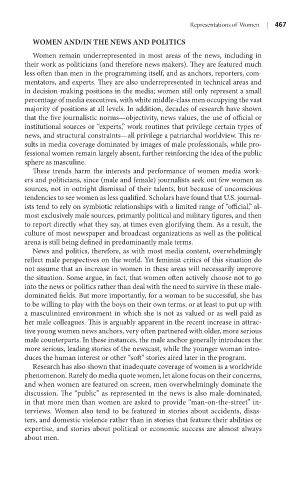Page 488 - Battleground The Media Volume 1 and 2
P. 488
Representat ons of Women |
womEn anD/in ThE nEws anD PoLiTiCs
Women remain underrepresented in most areas of the news, including in
their work as politicians (and therefore news makers). They are featured much
less often than men in the programming itself, and as anchors, reporters, com-
mentators, and experts. They are also underrepresented in technical areas and
in decision-making positions in the media; women still only represent a small
percentage of media executives, with white middle-class men occupying the vast
majority of positions at all levels. In addition, decades of research have shown
that the five journalistic norms—objectivity, news values, the use of official or
institutional sources or “experts,” work routines that privilege certain types of
news, and structural constraints—all privilege a patriarchal worldview. This re-
sults in media coverage dominated by images of male professionals, while pro-
fessional women remain largely absent, further reinforcing the idea of the public
sphere as masculine.
These trends harm the interests and performance of women media work-
ers and politicians, since (male and female) journalists seek out few women as
sources, not in outright dismissal of their talents, but because of unconscious
tendencies to see women as less qualified. Scholars have found that U.S. journal-
ists tend to rely on symbiotic relationships with a limited range of “official,” al-
most exclusively male sources, primarily political and military figures, and then
to report directly what they say, at times even glorifying them. As a result, the
culture of most newspaper and broadcast organizations as well as the political
arena is still being defined in predominantly male terms.
News and politics, therefore, as with most media content, overwhelmingly
reflect male perspectives on the world. Yet feminist critics of this situation do
not assume that an increase in women in these areas will necessarily improve
the situation. Some argue, in fact, that women often actively choose not to go
into the news or politics rather than deal with the need to survive in these male-
dominated fields. But more importantly, for a woman to be successful, she has
to be willing to play with the boys on their own terms, or at least to put up with
a masculinized environment in which she is not as valued or as well paid as
her male colleagues. This is arguably apparent in the recent increase in attrac-
tive young women news anchors, very often partnered with older, more serious
male counterparts. In these instances, the male anchor generally introduces the
more serious, leading stories of the newscast, while the younger woman intro-
duces the human interest or other “soft” stories aired later in the program.
Research has also shown that inadequate coverage of women is a worldwide
phenomenon. Rarely do media quote women, let alone focus on their concerns,
and when women are featured on screen, men overwhelmingly dominate the
discussion. The “public” as represented in the news is also male-dominated,
in that more men than women are asked to provide “man-on-the-street” in-
terviews. Women also tend to be featured in stories about accidents, disas-
ters, and domestic violence rather than in stories that feature their abilities or
expertise, and stories about political or economic success are almost always
about men.

